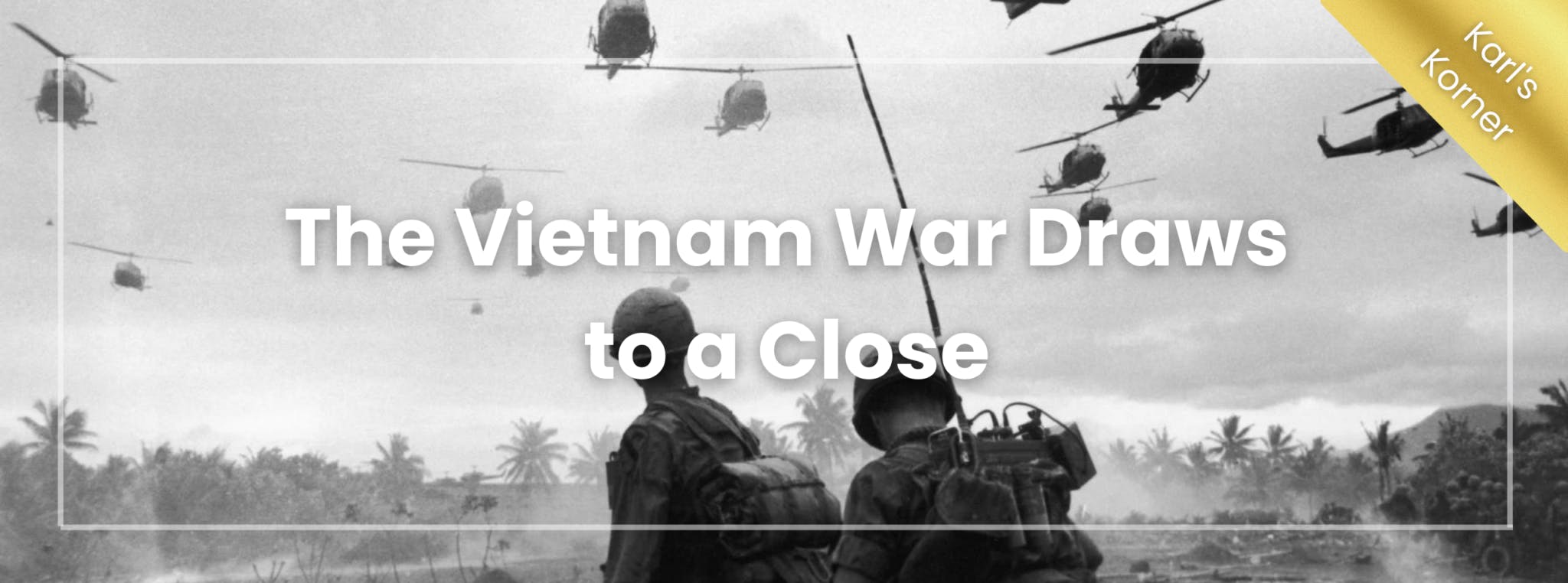 March 22, 2023 | Karl’s Korner
March 22, 2023 | Karl’s KornerThe Vietnam War Draws to a Close
The eventual disengagement of American military forces in South Vietnam began shortly after Richard Nixon’s election to the presidency in 1968 with a determination to preserve South Vietnam’s sovereignty without a combat commitment. This endeavor required building Saigon’s military in a “Vietnamization” process while dividing support among Hanoi’s communist allies of China and the Soviet Union.
Nixon stunned the world with his visit to Beijing in 1972, and carried on with separate negotiations in Moscow. Both efforts helped bring on a period of détente in the 1970s. Simultaneously, faltering cease-fire talks with North Vietnamese officials in Paris resumed with Secretary of State Henry Kissinger.
By 1972, most U.S. and allied ground forces had been withdrawn from South Vietnam, but talks in Paris fell apart in March. Seeing an opportunity, North Vietnamese military planners in Hanoi ordered an offensive against the South. They attacked with conventional military forces, however, as its guerilla apparatus inside South Vietnam had been shattered after the Tet Offensive four years earlier.
This new round of fighting saw initial success, particularly in the Quang Tri Province, just south of the Demilitarized Zone separating the two Vietnams. In response, the Nixon administration ordered extensive aerial counterstrikes, which aided a remarkable rebound by South Vietnamese forces that regained most of the ground at a considerable cost to the North.
One of the U.S. military responses was Operation Linebacker I, which massively resumed bombing missions over North Vietnam. In just six months, aerial raids from land bases and U.S. Navy aircraft carriers positioned in the Tonkin Gulf destroyed Hanoi’s fighter bases, oil storage reserves, and major power plants. Its principal harbor, Haiphong, was mined and closed to outside ship traffic.
Talks in Paris resumed in August but collapsed again in December, which prompted Nixon to continue the U.S. air raids with Operation Linebacker II, which also included mass B-52 attacks on military targets in Hanoi. With its air defense network smashed, the North Vietnamese returned to the negotiating table.
Realizing that the Americans needed to be negotiated out of the picture, the new talks proceeded apace. The Paris Peace Accords were quickly finalized and the treaty officially “ending the war and restoring peace in Vietnam” was ultimately signed on Jan. 27, 1973. Coincidentally, the signing occurred on the same day the military draft ended in the United States.
While remaining U.S. forces in South Vietnam were withdrawn in exchange for repatriating all U.S. Prisoners of War (POWs), the North retained substantial forces around the periphery of South Vietnam. Pledges by both Vietnamese governments to abide by the peace treaty were soon revoked, just as was the case with the Geneva Accords of 1954 that brought an end to the First Indochina War and marked the close of France’s influence in Southeast Asia. On March 29, last U.S. troops left Vietnam and the final group of American POWs were freed from captivity and departed Hanoi.
By 1974, however, Hanoi was well-positioned to resume the war. Nixon was no longer president and the South Vietnamese economy was reeling from the oil embargo crisis impacting Western economies. In December, North Vietnamese forces began probing attacks northeast of Saigon and incurred no response from President Gerald Ford’s administration. Seeing no external resistance from the United States, Hanoi steadily built up its forces before the dry season ended and launched more attacks in March 1975.
These probes yielded surprising gains, and when South Vietnamese forces botched a complicated redeployment from the Central Highlands, the invaders kept the initiative and rolled up the rest of the country in the ensuing weeks. By mid-April Cambodia had fallen to local communist forces, and Saigon was under siege.
Over the course of 30 hours on April 29-30, U.S. Air Force helicopters flying from carriers stationed off the coast of Saigon evacuated American civilians and South Vietnam’s government members. Thousands of terrified South Vietnamese flew out, most on commandeered military helicopters around Saigon. South Vietnam fell on April 30, ending more than thirty years of regional conflict.
Launch em’… until next time,
Karl
Your Adventure Starts Now
Your email is the key to information that will open up all your possibilities for exploring the mighty Midway!

